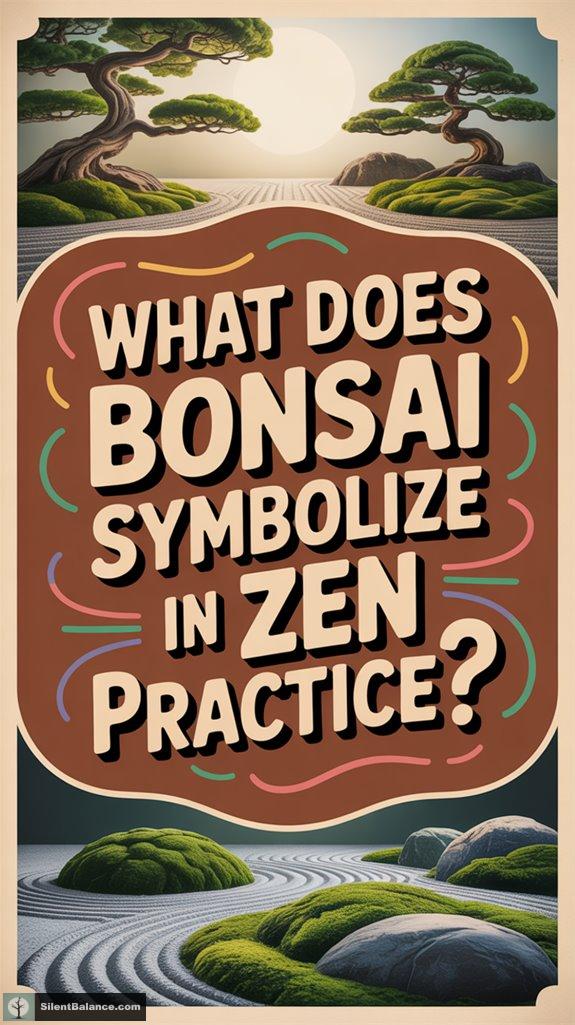Bonsai, in Zen practice, symbolizes a beautiful blend of balance, mindfulness, and simplicity. It’s like crafting a miniature world that flickers with life’s energy, showing us that even the tiniest elements need care and patience to thrive. Each twist of wire and snip of foliage isn’t just about aesthetics, it’s a meditative dance with nature. Isn’t it intriguing how these little trees mirror our personal growth? Stick around, and you’ll discover even more layers to this artful journey!
Quick Takeaways
- Bonsai represents harmony between humans and nature, reflecting Zen ideals of mindfulness and presence.
- The practice of bonsai embodies simplicity and balance, inviting peace and tranquility into daily life.
- Wabi-sabi philosophy in bonsai highlights transience, showcasing resilience and the beauty of imperfection.
- Care for bonsai encourages mindfulness, fostering patience and emotional connection with nature.
- Asymmetrical forms in bonsai symbolize the dance with nature’s spontaneity, reinforcing balance in personal environments.
The Historical Roots of Bonsai and Zen Buddhism
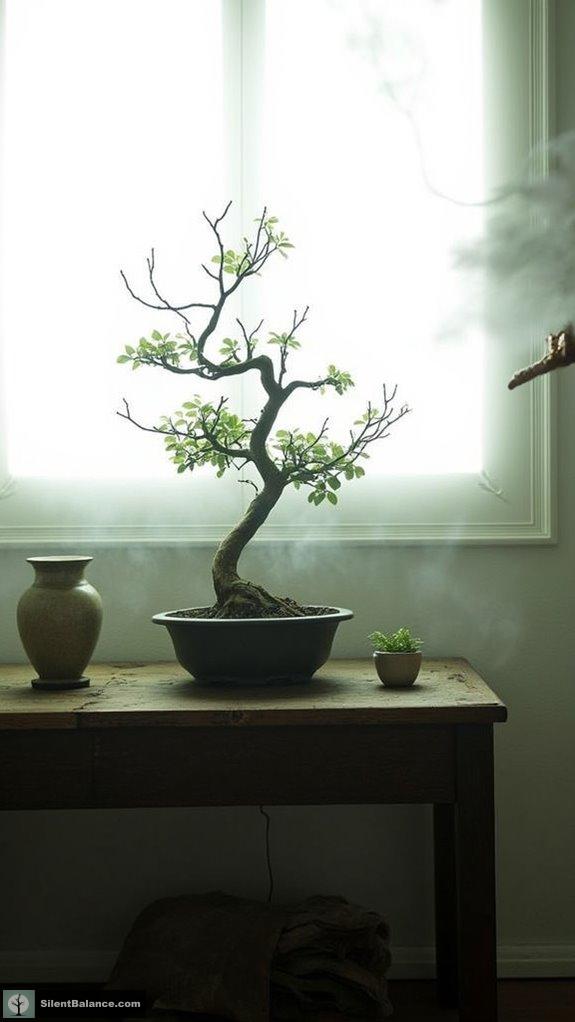
Although many might think of bonsai as just a quirky little tree on a windowsill, its historical roots dive deep into the intertwining cultures of China and Japan, particularly with its fascinating ties to Zen Buddhism.
Originating from the penjing practice, bonsai represents a refined mini terrain rather than just a lone tree. Can you envision early elites cultivating nature in tiny trays? The art of bonsai not only reflects a meditative state but also embodies the harmony between humans and nature.
When Buddhist monks discovered penjing, they introduced it to Japan, merging it with Zen ideals. This remarkable art emphasizes the synthesis of discipline and simplicity, creating a meditative practice. Isn’t it amazing how such small trees can hold so much meaning?
Essence of Simplicity and Balance in Bonsai
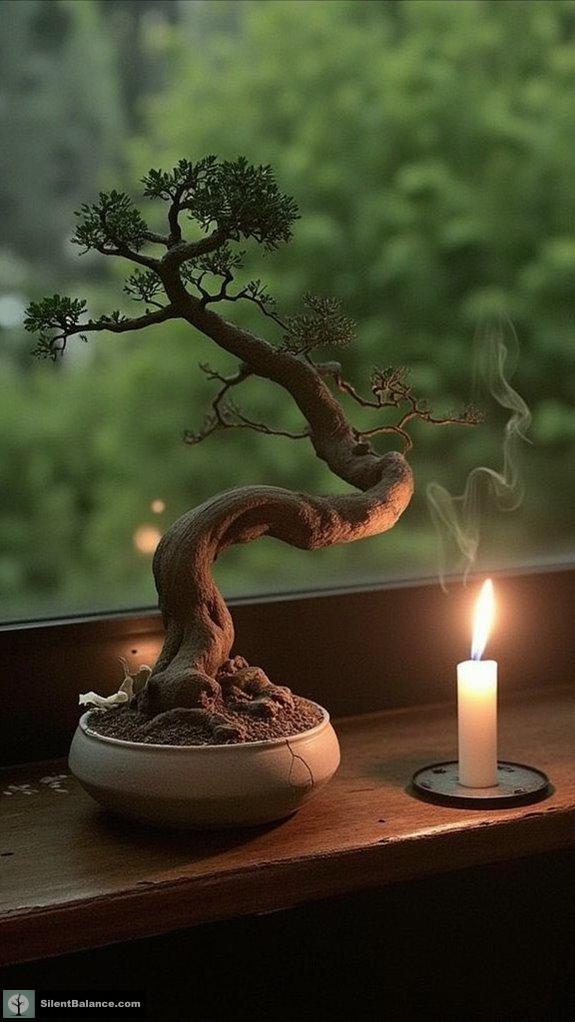
Bonsai is more than just a tiny tree; it’s a living embodiment of the art of simplicity and balance.
In bonsai, asymmetry reigns supreme, celebrating life’s inherent imperfections. Who needs perfect lines when the beauty lies in the irregular? The practice of nurturing bonsai also symbolizes harmony with nature, reminding us of our interconnectedness with the world around us.
Asymmetry shines in bonsai, revealing beauty in life’s imperfections and inviting us to embrace the irregular.
You’ll find that a minimalist approach accentuates the essence—less is truly more! Bonsai art reflects the essence of nature, ultimately guiding us toward deeper appreciation.
It’s all about peering past complexities to discover tranquility, inviting you into a meditative state.
So, why not embrace the sparse aesthetics? This art form gently nudges us toward inner peace, inviting a dance between strength and fragility.
Can you feel the harmony?
Welcome to the world of Zen bonsai!
Embracing Impermanence: Wabi-Sabi and Bonsai

In the world of bonsai, the notion of impermanence weaves a complex tapestry that speaks to the heart of wabi-sabi—a philosophy that celebrates the beauty of transience and the passage of time.
I’ve always found that each weathered bonsai tells a story of resilience, with imperfections embracing the very essence of aging. Doesn’t that resonate deeply?
The rough textures and asymmetry of my trees reveal nature’s artistry, elevating simplicity over perfection. As I prune, I ponder their journey, mindful of time’s gentle touch. Isn’t that a unique viewpoint?
In this embrace of decay, I find peace—an exquisite balance between control and surrender. This harmonious relationship embodies the symbolism of bonsai display styles, further enriching the practice’s aesthetic and philosophical depth.
Cultivating Mindfulness Through Bonsai Care

Mindfulness and bonsai care go hand in hand, creating a dynamic duo that fosters inner peace and vibrant growth.
Have you ever found yourself fully present while trimming the delicate leaves of your tree? That’s active meditation at its best! Engaging all your senses—feeling the texture, smelling the fresh foliage—anchors your attention in the moment.
As you shape and wire, you cultivate patience, mirroring self-care. Each tiny adjustment is a representation of your commitment, both to the tree and your mental well-being.
Reflecting Personal Growth in Bonsai Cultivation

When you plunge into the world of bonsai cultivation, you quickly realize that the journey outward mirrors the journey inward. Each twist and turn in shaping your bonsai teaches you patience and perseverance—no rush here!
Have you ever noticed how stubborn branches require constant tweaking? Every snip, every wire, signifies growth that demands resilience and commitment, just like life’s ups and downs.
Stubborn branches require ongoing care, reflecting our need for resilience and commitment in life’s twists and turns.
As we embrace imperfections in our miniature trees, we cultivate humility and acceptance. Bonsai isn’t just a hobby; it’s an ongoing lesson in adaptability, reminding us that mastery evolves with time, much like our own personal journeys.
How’s that for growth?
Symbolism of Balance and Coexistence in Nature
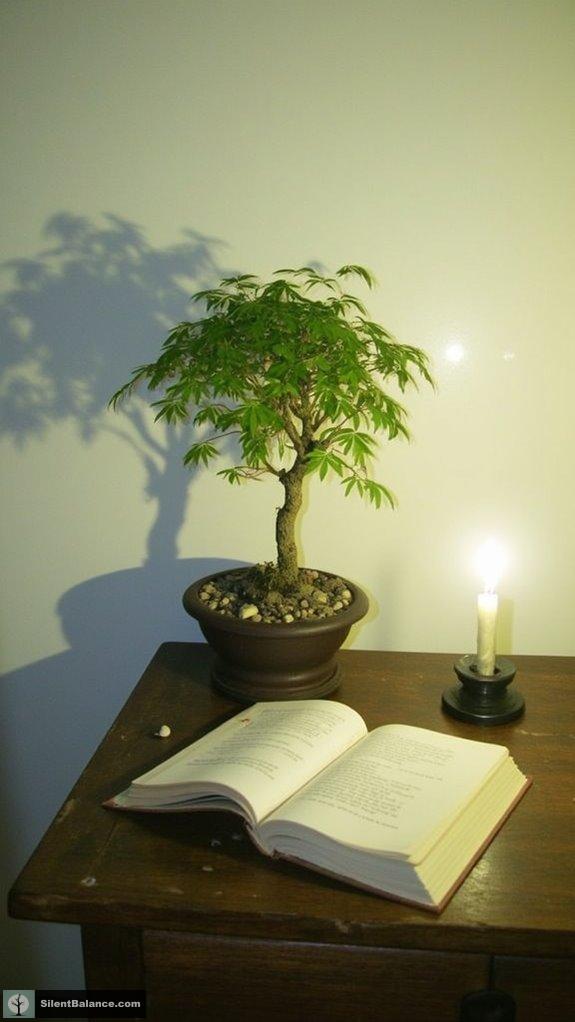
Balance and coexistence in nature are woven into the very fabric of bonsai cultivation, creating a rich tapestry of symbolism that resonates deeply with our human experience.
When you shape a bonsai, you’re not just trimming; you’re engaging in a dance with nature’s spontaneity. Ever noticed how that asymmetrical form feels more alive? It’s a Zen reminder that perfection’s overrated.
As you nurture your little tree, you build a bond, respecting its rhythms. Isn’t it satisfying to cultivate such harmony?
The simplicity of bonsai invites you to reflect, turning your space into a sanctuary. This isn’t just art; it’s a lifestyle that encourages balance!
Bonsai Tree Symbolism

Bonsai trees aren’t just miniature versions of their full-sized counterparts; they’re living sculptures that embody deep and exciting symbolism.
These tiny wonders capture the essence of wabi-sabi, embracing natural imperfections like rugged bark and twisted branches. Isn’t it fascinating how a little tree can mirror our own life cycles?
As I nurture my bonsai, I’m reminded of patience and mindfulness. The act of caring fosters a deep bond, blending nature and human touch.
And let’s be real—who doesn’t love a bit of zen in their living room?
Tree Symbolism
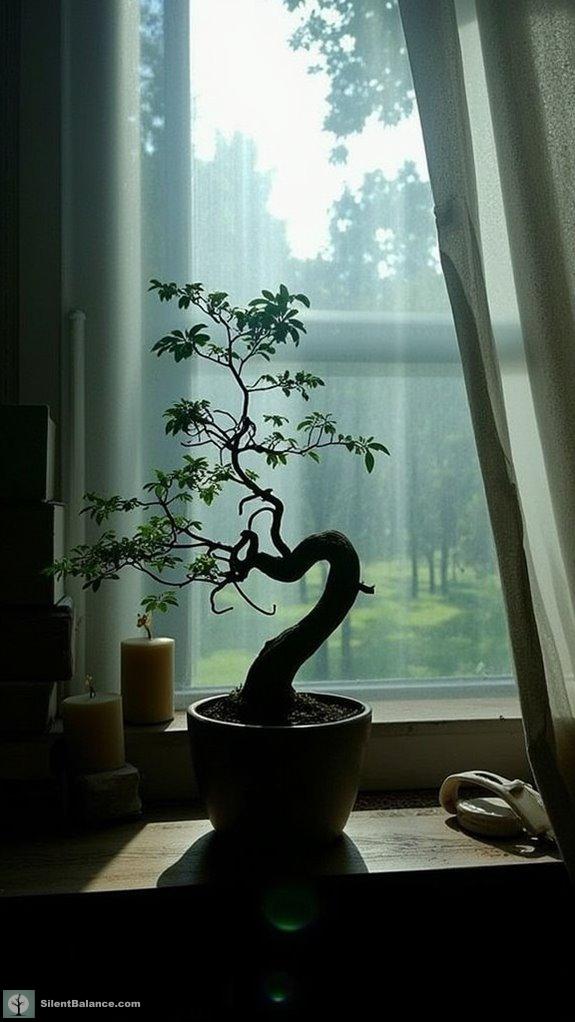
Trees hold a special place in our hearts, especially within the world of Zen.
They’re not just wooden giants; they symbolize our journey toward spiritual growth and enlightenment. Ever heard of the Bodhi tree? It’s the original tree of awakening!
Plus, think about how trees breathe—just like us. Their roots dig deep, reminding us to nurture our inner selves while we’re reaching for the sky.
Trees breathe life into our world, grounding us deep as we aspire towards greater heights.
And what’s more Zen than that quiet, enduring presence?
Questions and Answers
Can Bonsai Trees Be Grown Indoors for Zen Practice?
Absolutely, I grow bonsai indoors myself. With the right light, humidity, and care, they thrive beautifully, offering a serene presence. It’s a fulfilling practice that enhances my mindfulness and connection with nature every day.
How Do I Choose a Bonsai Tree for Meditation?
When I choose a bonsai for meditation, I focus on species that fit my space, promote calmness, and match my caregiving skills. Healthy, visually appealing trees enhance tranquility and mindfulness in my practice.
What Tools Are Essential for Bonsai Care?
A stitch in time saves nine. For bonsai care, I rely on pruning shears, concave cutters, and wire pliers. Each tool gives me the control I crave, shaping my bonsai with precision and purpose.
Is Bonsai Cultivation Suitable for Beginners?
Is bonsai cultivation suitable for beginners? Absolutely! I’ve found that choosing indigenous species and utilizing starter kits makes it easy. With patience and proper tools, anyone can enjoy this rewarding and artistic hobby.
Can Bonsai Trees Survive in Harsh Climates?
When I first tried bonsai, I feared harsh winters would destroy my trees. Yet, I’ve learned that with care and protective measures, even the toughest climates can’t deter their beauty and resilience. You control their fate.
References
- https://daitool.com/blogs/daitool-blog/what-is-a-bonsai-tree-symbolism-care-and-tips-for-growing-your-own
- https://sendplants.com/blogs/news/the-meaning-symbolism-and-significance-of-bonsai-trees
- https://www.bokksu.com/blogs/news/bonsai-the-delicate-art-of-japanese-miniature-trees
- https://bonsai2u.co.uk/the-meaning-of-bonsai/
- https://www.deccanherald.com/opinion/the-symbolism-of-bonsai-1038432.html
- https://cannabonsai.com/a-short-history-of-bonsai/
- https://www.bonsaiempire.com/origin/bonsai-history
- https://en.wikipedia.org/wiki/Bonsai
- https://deeperjapan.com/the-history-of-bonsai
- https://www.yorkshirebonsai.co.uk/blogs/news/the-origins-of-bonsai-a-journey-through-time-and-culture
- Bonsai Placement Benefits for Room Harmony - November 8, 2025
- Why Use Air Layering to Propagate Bonsai Trees? - November 8, 2025
- 15 Stunning Acorn Wood Wall Art Ideas - November 8, 2025

